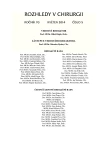Complications after percutaneous transhepatic drainage of the biliary tract
Authors:
P. Kothaj 1; S. Okapec 2; A. Kúdelová 3
Authors‘ workplace:
II. chirurgická klinika SZU FNsP F. D. Roosevelta Banská Bystrica, prednosta: Prof. MUDr. P. Kothaj, CSc.
1; Oddelenie rádiológie FNsP F. D. Roosevelta Banská Bystrica, primár: MUDr. S. Okapec
2; ADOS SANAS Topoľčany, vedúca sestra: PhDr. A. Kúdelová, PhD.
3
Published in:
Rozhl. Chir., 2014, roč. 93, č. 5, s. 247-254.
Category:
Original articles
Overview
Introduction:
The aim of this work is to demonstrate perioperative and postoperative complications after percutaneous transhepatic drainage of the biliary tract and, on the basis of our own experience, to show the possibilities of solving these complications within hospital care as well as the ways of preventing such complications in outpatient and home care where the role of home care nurses is very important.
Material and methods:
At the Department of Radiology in F.D. Roosevelt Teaching Hospital Banska Bystrica, more than 100 percutaenous transhepatic biliary tract drainage procedures are performed every year. In 2013, 105 such procedures were performed. Indications included nonresectable cholangiocarcinomas of the biliary confluence (Klatskin tumours) or common bile duct as well as benign bile obstructions in which endoscopic drainage could not be performed (benign stenosis of thecommon bile duct, stenosis of biliodigestive anastomosis, intrahepatic biliary stones). Between 2009 and 2013, 151 patients with percutaneous transhepatic drainage of the biliary tract were hospitalised at the Department of Surgery in F.D. Roosevelt Hospital Banska Bystrica,of whom 98 had malignant obstruction and 53 benign obstruction.
Results:
In 151 patients hospitalised at the Department of Surgery, the following postoperative complications occurred: catheter obliteration in 6.6%, biliary peritonitis in 2%, sepsis with cholangitis in 3.3% and haemorrhage in 4.6% of all patients. Mortality directly related to the PTD procedure was 0.66% (1 patient).
Conclusion:
Percutaneous transhepatic biliary tract drainage requires a skilled radiologist who is able to manage all perioperative complications. At the same time, experienced medical staff are needed who are able to treat the drainage catheters correctly and are able to recognize severe complications in time. Complications after PTD occur also during home care of the patients; therefore, cooperation of home care nurses with hospitals where PTD is performed is therefore important. Catheter flushing should be included in the catalogue listing home care procedures.
Key words:
percutaneous transhepatic drainage – complications – home care
Sources
1. Clouse ME, Evans D, Costello P, et al. Percutaneous transhepatic biliary drainage. Complications due to multiple duct obstructions. Ann Surg 1983;198 : 25–29.
2. Taormina V, McLean GK. Chronic bile peritonitis with progressive bile ascites: a complication of percutaneous biliary drainage. Cardiovasc Intervent Radiol 1985;8 : 103–5.
3. Levine JG, Botet J, Kurtz RC. Microbiological analysis of sepsis complicating non-surgical biliary drainage in malignant obstruction. Gastrointest Endosc 1990;36 : 364–8.
4. Fontein DB, Gibson RN, Collier NA. Two decades of percutaneous transjejunal biliary intervention for benign biliary disease: a review of the intervention nature and complications. Insights Imaging 2011;2 : 557–565.
5. Pessa ME, Hawkins IF, Vogel SB. The treatment of acute cholangitis. Percutaneous transhepatic biliary drainage before definitive therapy. Ann Surg 1987;205 : 389–392.
6. Saad WE, Davies MG, Darcy MD. Management of bleeding after percutaneous transhepatic cholangiography or transhepatic biliary drain placement. Tech Vasc Interv Radiol 2008;11 : 60–71.
7. Brozinsky S, DeSoto-Lapaix F, Jimenez FA, et al. Bile emboli: a complication of PTD. J Clin Gastroenterol 1981;3 : 135–7.
8. Saad WE, Wallace MJ, Wojak JC, et al. Quality improvement guidelines for percutaneous transhepatic cholangiography, biliary drainage and percutaneous cholecystostomy. J Vasc Interv Radiol 2010;21 : 789–795.
9. Sedmík J, Mrázová J, Hrobař P. Péče o drén a komplikace po perkutánní transhepatické drenáži žlučových cest. Praktický lékař 2005;85 : 145–147.
Labels
Surgery Orthopaedics Trauma surgeryArticle was published in
Perspectives in Surgery

2014 Issue 5
Most read in this issue
- Complications after percutaneous transhepatic drainage of the biliary tract
- Superficial thrombophlebitis of the lower limbs from the surgeon’s point of view
- Pelvic ring injury as part of multiple trauma
- Retroperitoneal neurogenous tumors
